#indigenous peoples institutions
Explore tagged Tumblr posts
Text
4th Meeting, Second Intersessional Meeting on the Participation of Indigenous Peoples - UN Human Rights Council.
This intersessional meeting is the second of two mandated under paragraph 16 of resolution 54/12, in which the Council decided to "continue to discuss and develop further steps and measures necessary to enable and to facilitate the participation of Indigenous Peoples' representatives and institutions duly established by themselves in the work of the Human Rights Council." The first intersessional meeting was held on 18 and 19 July 2024.
Watch the 4th Meeting, Second Intersessional Meeting on the Participation of Indigenous Peoples - UN Human Rights Council!

#indigenous#tribal groups#aboriginal#indigenous community media#plenary sessions#indigenous rights#un human rights council#right to participation#indigenous participation#participation#indigenous peoples representatives#indigenous peoples institutions
0 notes
Text
story about a heist team doing a heist of colonial museums and returning unethically stolen sacred objects and objects of cultural patrimony to their original communities
but the story isn’t about them
the story is a legal thriller about the repatriation coordinator and the pro bono lawyer who get frantically called in by that community when an artifact goes missing from a museum and shows up unexpectedly at their doorstep and now they are in a shit ton of (potentially international) legal trouble because the heist team did not take the legal ramifications into account, and no one else believes them that they didn’t steal it, and The Law is saying they are legally obligated to return it to the museum and are also probably going to go to prison for this, and activists are protesting, and it’s rocking the repatriation world, and it’s turning into a huge Thing
#I enjoy the museum heist repatriation fantasy as much as the next person but there is a reason people don’t just do that#The theme can be the unfair prioritization of colonial laws over indigenous rights and the inherent ethical unbalance#Of making repatriation the choice of the institution to do or not do#But like. A museum heist would not end in a ‘oh sorry guess you have it now and we can’t do anything about it’#repatriation
2K notes
·
View notes
Text

Mitákuye Oyás’iŋ. Tapestry Institute. https://tapestryinstitute.org/mitakuye-oyasin/. Referencing Sicungu Lakota Elder Albert White Hat.
Their website defines itself thusly: Tapestry Institute weaves Indigenous Knowledge to life through activities and publications that use Indigenous ways of knowing, learning about, and responding to the natural world. The particular post I am referencing is about the Lakota phrase ‘Mitakuye Oyasin’ (also spelled as Mitákuye Oyás’iŋ, mitákuye oyásʾį). “The Lakota phrase Mitákuye Oyás’iŋ describes Reality by addressing it as “All My Relations.” All humans, all animals, all plants, all the waters, the soil, the stones, the mountains, the grasslands, the winds, the clouds and storms, the sun and moon, stars and planets are our relations and are relations to one another. We are connected to each other in multiple and vital ways. When one is in pain, all are harmed. When there is justice for one, there is more justice for all.”
This quote is important as it confirms the idea that ‘Mitakyue Oyasin’ is more than merely a meaningful phrase, but is a way of describing Reality. It also helps describe the sheer scope of what the words mean. What is also important to recognize is the belief in pain and justice also being interconnected as this can be connected to feminist ideas expressed within much queer ecology. But, the post also emphasizes that even though ‘All our Relations’ is the most common translation of the words, “the phrase actually bears within it rich layers of additional meaning that cannot be easily translated into English. It’s important to point this out because words and ideas, stories and rituals, are bound together into a single reality that must be respected, not misappropriated”.
youtube
Finally, the video interview with Albert White Hat adds even more complexity: the wisdom in these words are not “merely a collection of historical ideas or words” but “ a system of powerful knowledge applicable to the lives and struggles of people right now”. This ultimately supports my thesis; that indigenous worldviews (in this case, Mitakuye Oyasin) can be in symbiosis/symbiopoesis with queer ecology--the concept is a tool (a much more besides) that can be applied to the struggle we face in healing our planet.
-- Symbiosis is any type of a close and long-term biological interaction between two biological organisms of different species
-- ‘Symbiopoesis’ or “how organisms can be intimately involved in each other’s development” (squid and light emitting bacteria, bees and pollination, acacia trees and ants, wasps and figs). (Rahder)
#queer ecology#tapestry institute#critical ecology#indigenous people#traditional ecological knowledge#mitakuye oyasin#symbiosis#symbiopoiesis#ecofeminism#queer theory#environmental politics#ecology#colonialism#Youtube
9 notes
·
View notes
Text
Religious/spiritual bipoc youth who have to grapple with generational trauma, religious guilt, and on top of that their own peers giving them a hard time for being religious/spiritual because it makes them "the enemy" or whatever... yea
#I was having thoughts last night#Usually I don't like stating my details; it makes me feel like I'm trying to appeal to something when my words are too weak;#but I don't want to make it sound like I'm speaking from nowhere; I'm very much speaking from somewhere#I'm African American with an Indigenous Caribbean background and I grew up Catholic with various spiritual beliefs#Separating my beliefs from my race and culture is impossible; at least if I would like to preserve authenticity;#but it seems like not everyone is on the same page about this at all#I'm not saying people should be forced to be happy about religion and religious institutions; they have issues aplenty;#but I am very much saying that religion and spirituality as a whole plays a major role in culture#and that if you want to appeal to poc you need to be willing to at least be accepting of people who practice religion and spirituality#Open-mindedness and respect is very useful; I don't see enough open-mindedness and respect; but that's the old person in me talking#People are too quick to be mean and judgmental; funny enough that's where a lot of microagressions come from#Like I have news for all the people who attacked me as a religious person and not as a racial minority; metaphorically
3 notes
·
View notes
Photo
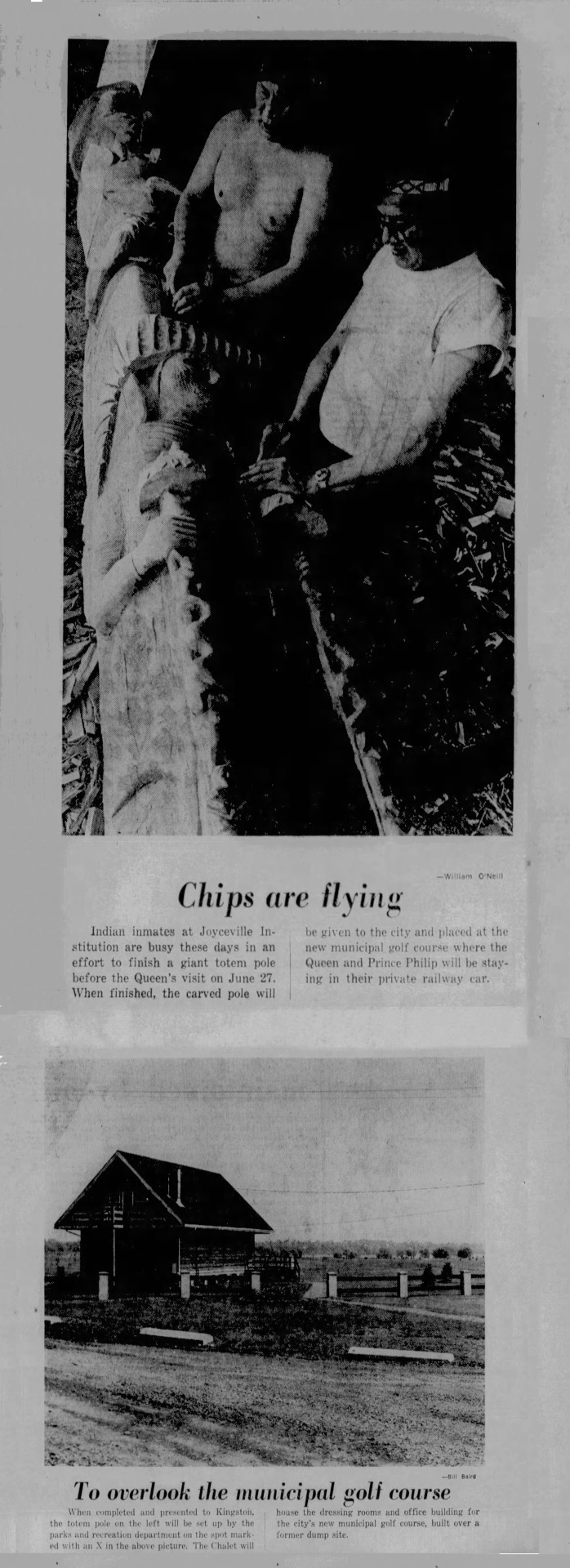
[The origin of the Belle Park totem pole in Kingston, Ontario, at least in part. Queen Elizabeth was visiting for the Kingston tercentenary, and this totem pole was one of a number made at that time by Indigenous inmates at Collin's Bay Penitentiary and Joyceville Institution, two medium security federal prisons in Kingston.
Who the carvers were, the inception of the project, whose idea was it, how it fits into the broader activities of the Native Brotherhood at Joyceville, all of that is still a little hazy to me - but the hard work of local researchers has resulted in a stupendous resource available here online: https://belleparkproject.com/the-place/totem-pole. It answers a lot of my questions and features the words of many of the carvers - a useful corrective to the Whig's slant here.
The Advance - the inmate newspaper at Joyceville - has a notice in June indicating OECA Channel 19 interviewed the totem pole carvers on May 18, for broadcast July 1 & 2 in Toronto. The Advance praises the tercentenary project as a "significant symbol of the role Native People have played in the evolvement of the Canadian people." Haven't read earlier issues yet to get a better feel.
In terms of outside newspaper coverage, there is this dramatic image from April 17 crediting MP Flora MacDonald for getting the wood shipping from BC. Which is all about how great the local Conservative MP is, not the carvers.
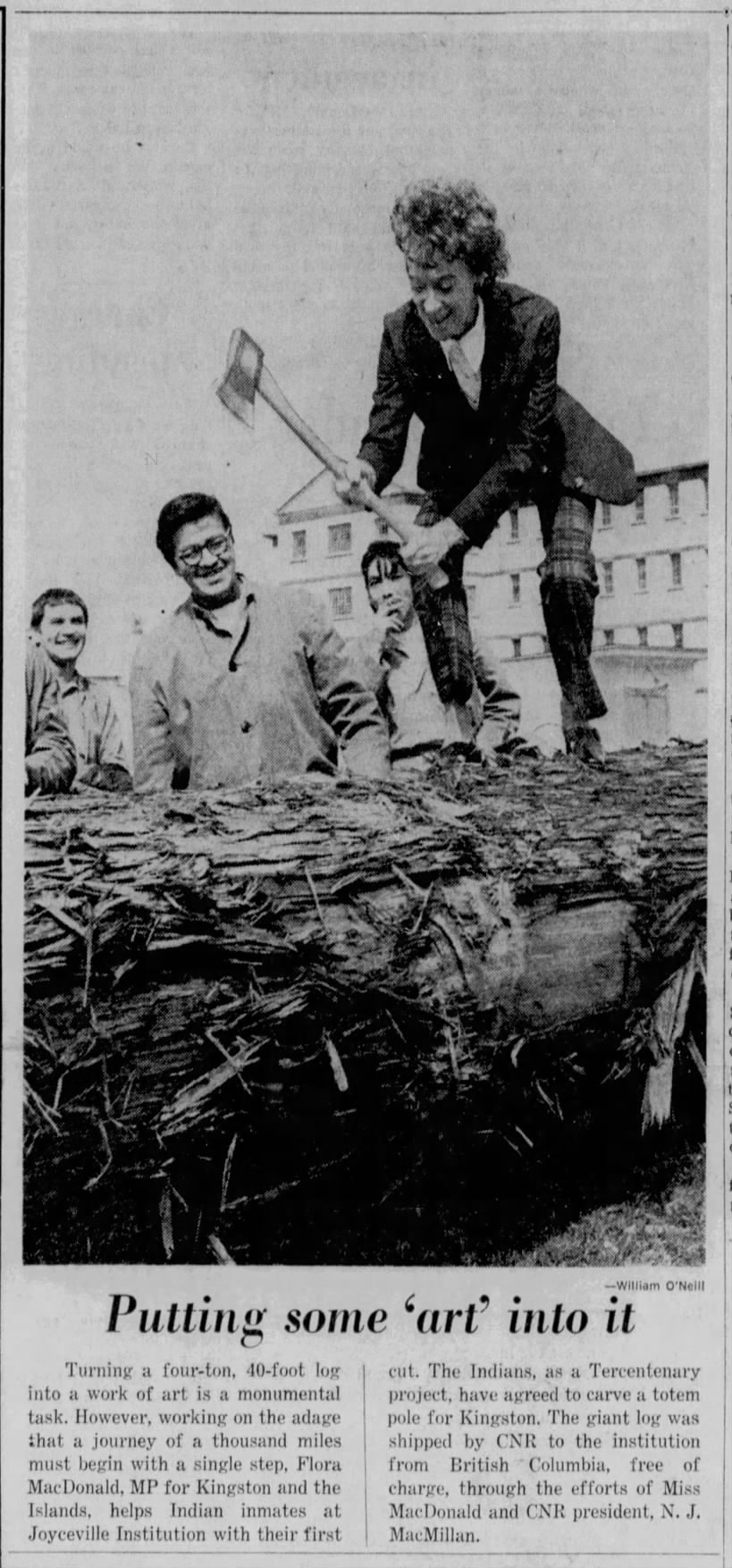
In terms of the broader context, Seth Adema's article “Native Brotherhoods and Decolonization in Ontario's Federal Prisons' is pretty crucial, and available for free online if you search. The totem pole is still on the Belle Park golf course, which has become during the pandemic a tent encampment for Kingston’s growing unhoused population. The city keeps trying to evict them all - presumably to re-open the golf course - while local solidarity activists try and stop it. Belle Island, where the park is partly located, is a site with great significance to the local First Nations, but was of course a garbage dump at one point because this is Canada...]
/// Captions for top images: "Chips are flying," Kingston Whig-Standard. June 8, 1973. Page 4. ---- Indian inmates at Joyceville Institution are busy these days in an effort to finish a giant totem pole before the Queen's visit on June 27. When finished, the carved pole will be given to the city and placed at the new municipal golf course where the Queen and Prince Philip will be staying in their private railway car.
(Photo by William O'Neill)
"To overlook the municipal golf course," Kingston Whig-Standard. June 8, 1973. Page 4. ---- When completed and presented to Kingston, the totem pole on the left will be set up by the parks and recreation department on the spot marked with an X in the above picture. The Chalet willhouse the dressing rooms and office building for the city's new municipal golf course, built over at former dump site.
(Photo by Bill Baird)
Captions for middle image: "Putting some art into it," Kingston Whig-Standard. April 17, 1973. Page 1. === Turning a four-ton 40-foot log into a work of art in a monumental task. However working on the adage that a journey of a thousand miles must begin with a single step Flora MacDonald MP for Kingston and the Islands helps Indian inmates at Joyceville Institution with their first cut. The Indians as a Tercentenary project have agreed to carve a totem pole for Kingston. The giant log was shipped by CNR to the institution from British Columbia free of charge, through the efforts of Miss MacDonald and CNR president MacMillan.
#kingston ontario#totem pole#tercentenary#joyceville institution#prisoners#indigenous prisoners#first nations#indigenous people#canadian history#native brotherhood#belle park#indigenous history#royal visit#life inside#history of crime and punishment in canada#crime and punishment in canada
9 notes
·
View notes
Text
This is one of my big hang ups with getting help in the behavorial health field; there are mostly neurotypical people pathologizing traits like “caring strongly about social justice issues/ unfairness” and they still somehow spin it as a bad thing. Not trying to derail the cluster b discussion - my experience is mostly with ADHD/Autism/Depression/Anxiety/CPTSD, but I have been told I might have a personality disorder because of how disregulated I presented at the office where I was actively getting more Trauma TM. It is just so baffling how stigmatizing this is toward everyone with so called “abnormal” brains / behaviors. Countering ableism and behavorial health stigma isn’t just about destigmitizing the socially acceptable/ “nice” disorders, but also the ones that aren’t as understood / accepted by society at large - especially when so much of the fear mongering comes from within the field itself.
I think people would armchair diagnose bad people with cluster B disorders much less if psychiatric disorders hadn't all been given names by ableists who of course picked the traits most unberarable to "sane" people to name them rather than, you know, the ways it affects the people that have them. It's like, when doctors are all "this disorder gives you extremely low self esteem. and it's called the Selfish Fucking Asshole Disorder" or "this disorder makes you want to die so bad. and it's called the Hysteric Bitch Disorder" or "this disorder disconnects you from your peers. and it's called the Insane Evil Cunt Disorder" and so on and so forth, so of course you have people going "oh, this person is a selfish fucking asshole, they MUST have Selfish Fucking Asshole Disorder! this further proves that all people with this disorder are like that in the first place!" Do You See It
#mental health history is disturbing#this type of stuff has been used historically to imprison “problematic people#including queer folks-women-Black-Indigenous-People-of-Color#anyone who disputed the status quo#behavorial health and medical institutions have MAJOR systemic issues akin to those in the police force
69K notes
·
View notes
Text
3rd Meeting, Second Intersessional Meeting on the Participation of Indigenous Peoples - Human Rights Council.
This intersessional meeting is the second of two mandated under paragraph 16 of resolution 54/12, in which the Council decided to "continue to discuss and develop further steps and measures necessary to enable and to facilitate the participation of Indigenous Peoples' representatives and institutions duly established by themselves in the work of the Human Rights Council." The first intersessional meeting was held on 18 and 19 July 2024
Watch the 3rd Meeting, Second Intersessional Meeting on the Participation of Indigenous Peoples - Human Rights Council!

#steps and measures necessary#indigenous#indigenous rights#right to participation#indigenous participation#participation#tribal groups#indigenous communities#intersessional meeting#indigenous peoples representatives#indigenous peoples institutions#palais des nations#un human rights council
0 notes
Text
okay I hate miracle cures and the people who push them as much as the next person but if you full stop hate all alternative/complementary medicine you’re straight up racist
#the assumption that only things that conform to your western way of knowing is limiting your understanding of the world#like drinking hot water w lemon and honey for a sore throat or drinking ginger or peppermint tea for nausea is alternative medicine#and those things do legitimately work and have been verified via the western institutions#so it stands to reason that there are a plethora of treatments and medicines outside of western medicine that can/would be ‘legit’#this is primarily an issue with indigenous treatments/medicine where white people write them off wholesale instead of approaching it from#the position that if people have been using a treatment for years it may have a legitimate use#and not that we shouldn’t investigate and find out more about the method of action#but discounting it immediately tells me you don’t think anything outside of your western bubble holds legitimacy
1 note
·
View note
Video
The idea that people are separate from the Earth has it's roots in colonialism, colonial exploitation, and the Enlightenment. Western science originated in this period and, because nothing exists in a vacuum, was influenced by the ideas of racial/cultural superiority, the idea that the land and those that lived on it were an extractive resource, and the idea that Western, mostly upper-class society were the default and superior, and therefore above the resources (land/people/animals/ect.) they sought to exploit. All these became justifications of colonial power and blended into early western science's development, and even now, there in an insistence in science, especially the hard sciences, that the researcher is an unbiased force, when in reality, everything from what is studied, the way a study is conducted, to the conclusions the researcher draws are all influenced by the culture the researcher lives in.
The persistent idea that any part of this country was uninhabited or had an unmanaged landscape is directly a result of colonial powers trying to strip the legitimacy of indigenous peoples from their sovereignty and open that land up to colonial settlement and/or resource exploitation. Most of the National Parks were formed in this way. But the western mindset of nature and the land being separate is at the basis of a lot of how western environmental movements operate, which then immediately comes into contention with indigenous communities who point out that that has never been the case and who are trying to reassert their land and resource rights.
If you want to read more, "As Long as Grass Grows" by Dina Gilio-Whitaker is a really accessible and in depth look at a lot of this
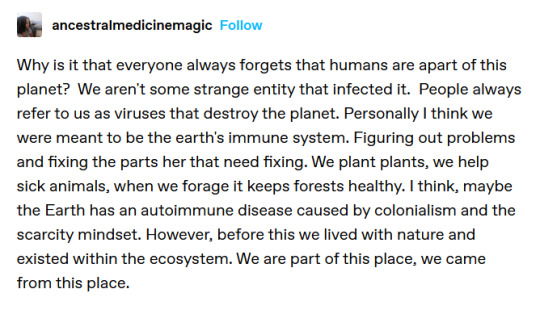
#These are all problems that we're currently working through in my fields#but thankfully there has been a lot of progress made over the last ~10 years#and more than half the students in my indigenous science class are from ecology or biology#so the tide is turning#most of the problem is the rigidity of academia as in institution#the sociopolitical and economic forces the prevent a lot of indigenous peoples from being represented in the sciences#and of course that we live in a Neoliberal Hellscape
31K notes
·
View notes
Text
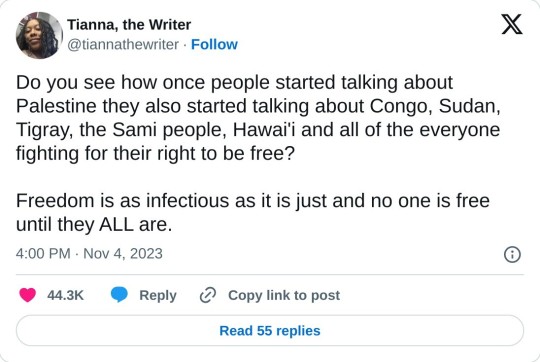
People & countries mentioned in the thread:
DR Congo - M23, Cobalt
Darfur, Sudan - International Criminal Court, CNN, BBC (Overview); Twitter Explanation on Sudan
Tigray - Human Rights Watch (Ethnic Cleansing Report)
the Sámi people - IWGIA, Euronews
Hawai'i - IWGIA
Syria - Amnesty International
Kashmir- Amnesty Summary (PDF), Wikipedia (Jammu and Kashmir), Human Rights Watch (2022)
Iran - Human Rights Watch, Morality Police (Mahsa/Jina Amini - Al Jazeera, Wikipedia)
Uyghurs - Uyghur Human Rights Project (UHRP) Q&A, Wikipedia, Al Jazeera, UN Report
Tibetans - SaveTibet.org, United Nations
Yazidi people - Wikipedia, United Nations
West Papua - Free West Papua, Genocide Watch
Yemen - Human Rights Watch (Saudi border guards kill migrants), Carrd
Sri Lanka (Tamils) - Amnesty International, Human Rights Watch
Afghans in Pakistan - Al Jazeera, NPR
Ongoing Edits: more from the notes / me
Armenians in Nagorno-Karabakh/Azerbaijan (Artsakh) - Global Conflict Tracker ("Nagorno-Karabakh Conflict"), Council on Foreign Relations, Human Rights Watch (Azerbaijan overview), Armenian Food Bank
Baháʼís in Iran - Bahá'í International Community, Amnesty, Wikipedia, Minority Rights Group International
Kafala System in the Middle East - Council on Foreign Relations, Migrant Rights
Rohingya - Human Rights Watch, UNHCR, Al Jazeera, UNICEF
Montagnards (Vietnam Highlands) - World Without Genocide, Montagnard Human Rights Organization (MHRO), VOA News
Ukraine - Human Rights Watch (April 2022), Support Ukraine Now (SUN), Ukraine Website, Schools & Education (HRW), Dnieper River advancement (Nov. 15, 2023 - Ap News)
Reblogs with Links / From Others
Indigenous Ppl of Canada, Cambodia, Mexico, Colombia
Libya
Armenia Reblog 1, Armenia Reblog 2
Armenia, Ukraine, Central African Republic, Indigenous Americans, Black ppl (US)
Rohingya (Myanmar)
More Hawai'i Links from @sageisnazty - Ka Lahui Hawaii, Nation of Hawai'i on Soverignty, Rejected Apology Resolution
From @rodeodeparis: Assyrian Policy Institute, Free Yezidi
From @is-this-a-cool-url: North American Manipur Tribal Association (NAMTA)
From @dougielombax & compiled by @azhdakha: Assyrians & Yazidis
West Sahara conflict
Last Updated: Feb. 19th, 2024 (If I missed smth before this, feel free to @ me to add it)
#resources#important#congo#sudan#tigray#sámi#hawai'i#syria#kashmir#iran#uyghurs#china#tibetans#yazidi#west papua#yemen#sri lanka#afghans in pakistan#pakistan#human rights#palestine#twitter#lmk if there's a better reource or I linked smth wrong. I am very tired#my posts#genocide#social justice#nagorno karabakh#Bahá'í#kafala system#qatar
46K notes
·
View notes
Text
Technological innovations can empower Indigenous Peoples through mapping and securing customary land.

16.00-17.00 - Panel Discussion entitled'' Technological innovations can empower Indigenous Peoples through mapping and securing customary land."
Keynote speaker: Ramesh Sharma, Ekta Parishad Moderator: Eva Hershaw, International Land Coalition (ILC/IFAD)
Panelists
Ramesh Sharma, Ekta Parishad
Tania Eulalia Martinez Cruz, Land is Life
Jessica Webb, World Resources Institute
Maria Paula Rizzo, FAO Land Tenure and Indigenous Peoples Specialist
#21 march#international day of forests#Indigenous Peoples#International Land Coalition (ILC/IFAD)#fao forestry#customary land.#FAO Land Tenure and Indigenous Peoples#World Resources Institute#Land is Life#panel discussion#Technological innovations#forests and innovations
0 notes
Text
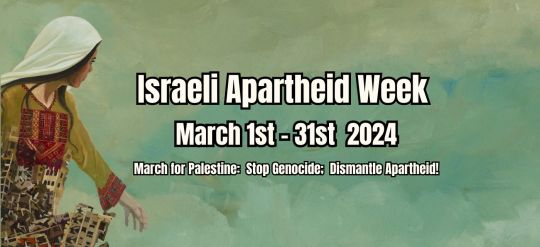
🇵🇸 From BDS:
This year’s Israeli Apartheid Week will be the most important since IAW was launched 20 years ago! With the ongoing Nakba at its height, Israel is carrying out the world’s first ever live-streamed genocide against 2.3 million Palestinians in Gaza while it continues to entrench its 75-year-old settler-colonial apartheid regime against all Indigenous Palestinians. Over the past few months, people around the world have carried out inspiring actions building people power to end state, corporate and institutional complicity in Israel’s #GazaGenocide and contribute to the Palestinian struggle for freedom, justice, and equality. With the failure of the international system, under US and Western hegemony, on full display, we will organize IAW throughout the month of March to bring justice from below. Save the date - March 1st - March 30th; an entire month of action and BDS mobilizations to end complicity in genocide, build grassroots power towards liberation and the dismantling of Israel’s settler-colonial apartheid regime. Let’s make this year’s IAW our most impactful ever!
In anticipation of the upcoming Israeli Apartheid Week, BDS has called for an escalation of our boycott campaigns.
To find out how you can join a specific BDS campaign, or how you can contribute towards IAW, you can use the search function on their website to find a BDS-affiliated organization in your country.

If you and your organization have an event planned for Israeli Apartheid Week (IAW), you can register them with BDS here.
🇵🇸 For individuals unaffiliated with an org, you can still support and participate in IAW by:
Boycotting all products from Israel and from companies profiting off the occupation of Palestine. Here are the official BDS targets. For a more extensive list of products, check in with one of the BDS affiliated organizations in your country (they might tell you, for instance, what processed food items at your local grocery store should be avoided).
Share information about BDS on social media, with friends and family, and with your local community.
For BDS targeted brands, refrain from making or sharing any content that helps that company's outreach and branding. No more memes mentioning the brand, no pictures showing their logo, no more free advertising. Boycotting here isn't just about the loss you as a costumer can inflict on the company by not purchasing their product, it's also about damaging the brand's reputation, and limiting their customer outreach.
I highly encourage you to join a BDS-affiliated org, but if for whatever reason you can't, then these are concrete and actionable steps you can take.
Again, for more information about BDS and Israeli Apartheid Week, you check in with the official BDS website.
#free palestine#palestine#israel#gaza#bds#boycott divest sanction#i'll set this up to be queued throughout feb/mar#and i'll also be sharing more BDS info/campaigns on this blog
10K notes
·
View notes
Text
Indigenous women have even higher maternal mortality rates in URBAN settings, than if they were back on the rez. It's got less to do with rural infrastructure than it does racism in health care. Black women's maternal mortality rates go hand in hand with other death causes in medical settings that they are disproportionately affected by due to racism in the industry. Aside from the other higher death risks black women face, I said all of this, with sources, in my original reply. It is not fearmongering, nor is it useless, to point out something that may be outside the WASP experience.
Additionally, the original point in the op was not solely about maternal mortality rates. Giving birth impacts/damages the body in a lot of ways. My mom had to deal with a prolapsed uterus later in life because of the three children (with their difficult labors) she had. That was with good insurance, and two were at one of the best maternity hospitals in her state. It needs to be spoken about, because health issues are treated like a moral failing. Which does not help things like PPD nor PPP.
I won't provide sources since obviously they're not being read, and as a disabled person I'm not big on pointlessly expending energy from my limited supply. Google Scholar is your friend, as is a thesaurus when you need to tweak your search terms.
the thing is like. i get that it's scary and makes people who do desire to get pregnant uncomfortable when we talk about the brutality and violence of pregnancy and the damage that pregnancy can do to your body
but you deserve to give informed consent to that process.
the lies around pregnancy - that it's inherently safe, that it doesn't do you permanent damage, that it's only extremely rare for people to die of pregnancy complications, etc like
all of these are lies constructed so that more people will get pregnant w/o knowing all that
there needs to be more talk about the impact of miscarriages and how common they are, how different abortion processes are and how accessible they are
but also like. talking about how pregnancy fucks your body up should not be taboo
this is a process that permanently changes most people's bodies, and that's even if the pregnancy doesn't do them like. severe illness or injury
and i just think everybody should have a right to KNOW that
bc to live in a society that intentionally obscures and hides facts about a completely optional and dangerous process does so for a reason, and that reason is based in a very sinister ideology that does not value bodily autonomy or informed consent
#I've been talking specifically about black and indigenous women because those are the sources I'd most recently seen#idk if there have been any pre and post partum studies with two spirit or trans people#maybe if i still had institutional access but i don't
76K notes
·
View notes
Text
The director of the New York Office of the High Commissioner for Human Rights of the UN (UN OHCHR), Craig Mokhiber, has resigned in a letter dated 28 October 2023
the resignation letter can be found embedded in this tweet by Rami Atari (@.Raminho) dated 31 October 2023.
The letters are here:
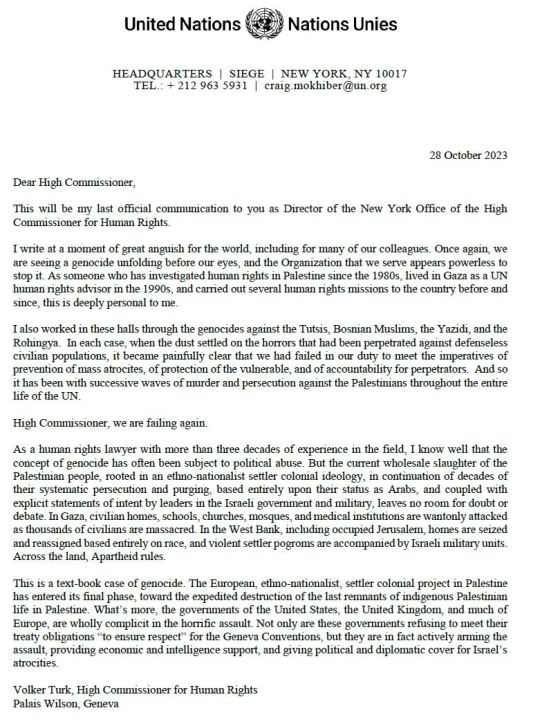
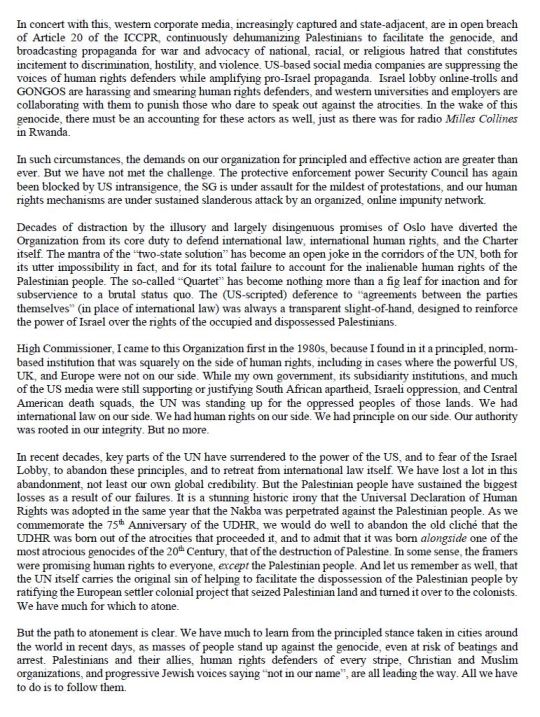
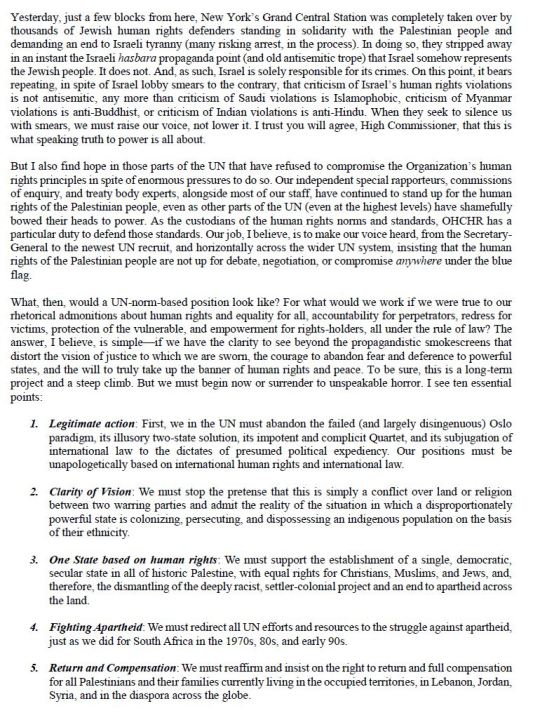
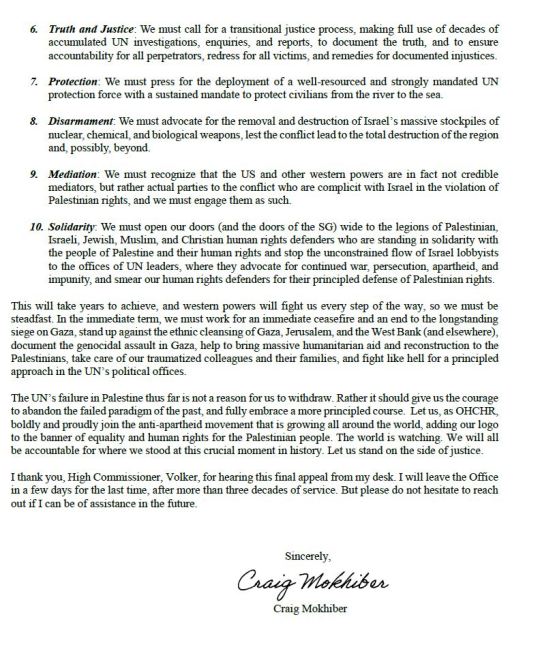
Transcription:
United Nations | Nations Unies
HEADQUARTERS I SIEGE I NEW YORK, NY 10017
28 October 2023
Dear High Commissioner,
This will be my last official communication to you as Director of the New York Office of the High Commissioner for Human Rights.
I write at a moment of great anguish for the world, including for many of our colleagues. Once again, we are seeing a genocide unfolding before our eyes, and the Organization that we serve appears powerless to stop it. As someone who has investigated human rights in Palestine since the 1980s, lived in Gaza as a UN human rights advisor in the 1990s, and carried out several human rights missions to the country before and since, this is deeply personal to me.
I also worked in these halls through the genocides against the Tutsis, Bosnian Muslims, the Yazidi, and the Rohingya. In each case, when the dust settled on the horrors that had been perpetrated against defenseless civilian populations, it became painfully clear that we had failed in our duty to meet the imperatives of prevention of mass atrocites, of protection of the vulnerable, and of accountability for perpetrators. And so it has been with successive waves of murder and persecution against the Palestinians throughout the entire life of the UN.
High Commissioner, we are failing again.
As a human rights lawyer with more than three decades of experience in the field, I know well that the concept of genocide has often been subject to political abuse. But the current wholesale slaughter of the Palestinian people, rooted in an ethno-nationalist settler colonial ideology, in continuation of decades of their systematic persecution and purging, based entirely upon their status as Arabs, and coupled with explicit statements of intent by leaders in the Israeli government and military, leaves no room for doubt or debate. In Gaza, civilian homes, schools, churches, mosques, and medical institutions are wantonly attacked as thousands of civilians are massacred. In the West Bank, including occupied Jerusalem, homes are seized and reassigned based entirely on race, and violent settler pogroms are accompanied by Israeli military units. Across the land, Apartheid rules.
This is a text-book case of genocide. The European, ethno-nationalist, settler colonial project in Palestine has entered its final phase, toward the expedited destruction of the last remnants of indigenous Palestinian life in Palestine. What's more, the governments of the United States, the United Kingdom, and much of Europe, are wholly complicit in the horrific assault. Not only are these governments refusing to meet their treaty obligations "to ensure respect" for the Geneva Conventions, but they are in fact actively arming the assault, providing economic and intelligence support, and giving political and diplomatic cover for Israel's atrocities.
Volker Turk, High Commissioner for Human Rights Palais Wilson, Geneva
In concert with this, western corporate media, increasingly captured and state-adjacent, are in open breach of Article 20 of the ICCPR, continuously dehumanizing Palestinians to facilitate the genocide, and broadcasting propaganda for war and advocacy of national, racial, or religious hatred that constitutes incitement to discrimination, hostility, and violence. US-based social media companies are suppressing the voices of human rights defenders while amplifying pro-Israel propaganda. Israel lobby online-trolls and GONGOS are harassing and smearing human rights defenders, and western universities and employers are collaborating with them to punish those who dare to speak out against the atrocities. In the wake of this genocide, there must be an accounting for these actors as well, just as there was for radio Mules Collins in Rwanda.
In such circumstances, the demands on our organization for principled and effective action are greater than ever. But we phave not met the challenge. The protective enforcement power Security Council has again been blocked by US intransigence, the SG [UN Secretary General] is under assault for the mildest of protestations, and our human rights mechanisms are under sustained slanderous attack by an organized, online impunity network.
Decades of distraction by the illusory and largely disingenuous promises of Oslo have diverted the Organization from its core duty to defend international law, international human rights, and the Charter itself. The mantra of the "two-state solution" has become an open joke in the corridors of the UN, both for its utter impossibility in fact, and for its total failure to account for the inalienable human rights of the Palestinian people. The so-called "Quartet" has become nothing more than a fig leaf for inaction and for subservience to a brutal status quo. The (US-scripted) deference to "agreements between the parties themselves" (in place of international law) was always a transparent slight-of-hand, designed to reinforce the power of Israel over the rights of the occupied and dispossessed Palestinians.
High Commissioner, I came to this Organization first in the 1980s, because I found in it a principled, norm-based institution that was squarely on the side of human rights, including in cases where the powerful US, UK, and Europe were not on our side. While my own government, its subsidiarity institutions, and much of the US media were still supporting or justifying South African apartheid, Israeli oppression, and Central American death squads, the UN was standing up for the oppressed peoples of those lands. We had international law on our side. We had human rights on our side. We had principle on our side. Our authority was rooted in our integrity. But no more.
In recent decades, key parts of the UN have surrendered to the power of the US, and to fear of the Israel Lobby, to abandon these principles, and to retreat from international law itself. We have lost a lot in this abandonment, not least our own global credibility. But the Palestinian people have sustained the biggest losses as a result of our failures. It is a stunning historic irony that the Universal Declaration of Human Rights was adopted in the same year that the Nakba was perpetrated against the Palestinian people. As we commemorate the 75th Anniversary of the UDHR, we would do well to abandon the old cliché that the UDHR was born out of the atrocities that proceeded it, and to admit that it was born alongside one of the most atrocious genocides of the 20th Century, that of the destruction of Palestine. In some sense, the framers were promising human rights to everyone, except the Palestinian people. And let us remember as well, that the UN itself carries the original sin of helping to facilitate the dispossession of the Palestinian people by ratifying the European settler colonial project that seized Palestinian land and turned it over to the colonists. We have much for which to atone.
But the path to atonement is clear. We have much to learn from the principled stance taken in cities around the world in recent days, as masses of people stand up against the genocide, even at risk of beatings and arrest. Palestinians and their allies, human rights defenders of every stripe, Christian and Muslim organizations, and progressive Jewish voices saying "not in our name", are all leading the way. All we have to do is to follow them.
Yesterday, just a few blocks from here, New York's Grand Central Station was completely taken over by thousands of Jewish human rights defenders standing in solidarity with the Palestinian people and demanding an end to Israeli tyranny (many risking arrest, in the process). In doing so, they stripped away in an instant the Israeli hasbara propaganda point (and old antisemitic trope) that Israel somehow represents the Jewish people. It does not. And, as such, Israel is solely responsible for its crimes. On this point, it bears repeating, in spite of Israel lobby smears to the contrary, that criticism of Israel's human rights violations is not antisemitic, any more than criticism of Saudi violations is Islamophobic, criticism of Myanmar violations is anti-Buddhist, or criticism of Indian violations is anti-Hindu. When they seek to silence us with smears, we must raise our voice, not lower it. I trust you will agree, High Commissioner, that this is what speaking truth to power is all about.
But I also find hope in those parts of the UN that have refused to compromise the Organization's human rights principles in spite of enormous pressures to do so. Our independent special rapporteurs, commissions of enquiry, and treaty body experts, alongside most of our staff, have continued to stand up for the human rights of the Palestinian people, even as other parts of the UN (even at the highest levels) have shamefully bowed their heads to power. As the custodians of the human rights norms and standards, OHCHR. has a particular duty to defend those standards. Our job, I believe, is to make our voice heard, from the Secretary-General to the newest UN recruit, and horizontally across the wider UN system, incisting that the human rights of the Palestinian people are not up for debate, negotiation, or compromise anywhere under the blue flag.
What, then, would a UN-norm-based position look like? For what would we work if we were true to our rhetorical admonitions about human rights and equality for all, accountability for perpetrators, redress for victims, protection of the vulnerable, and empowerment for rights-holders, all under the rule of law? The answer, I believe, is simple—if we have the clarity to see beyond the propagandistic smokescreens that distort the vision of justice to which we are sworn, the courage to abandon fear and deference to powerful states, and the will to truly take up the banner of human rights and peace. To be sure, this is a long-term project and a steep climb. But we must begin now or surrender to unspeakable horror. I see ten essential points:
Legitimate action: First, we in the UN must abandon the failed (and largely disingenuous) Oslo paradigm, its illusory two-state solution, its impotent and complicit Quartet, and its subjugation of international law to the dictates of presumed political expediency. Our positions must be unapologetically based on international human rights and international law.
Clarity of Vision: We must stop the pretense that this is simply a conflict over land or religion between two warring parties and admit the reality of the situation in which a disproportionately powerful state is colonizing, persecuting, and dispossessing an indigenous population on the basis of their ethnicity.
One State based on human rights: We must support the establishment of a single, democratic, secular state in all of historic Palestine, with equal rights for Christians, Muslims, and Jews, and, therefore, the dicmantling of the deeply racist, settler-colonial project and an end to apartheid across the land.
Fighting Apartheid: We must redirect all UN efforts and resources to the struggle against apartheid, just as we did for South Africa in the 1970s, 80s, and early 90s.
Return and Compensation: We must reaffirm and insist on the right to return and full compensation for all Palestinians and their families currently living in the occupied territories, in Lebanon, Jordan, Syria, and in the diaspora across the globe.
Truth and Justice: We must call for a transitional justice process, making full use of decades of accumulated UN investigations, enquiries, and reports, to document the truth, and to ensure accountability for all perpetrators, redress for all victims, and remedies for documented injustices.
Protection: We must press for the deployment of a well-resourced and strongly mandated UN protection force with a sustained mandate to protect civilians from the river to the sea.
Disarmament: We must advocate for the removal and destruction of Israel's massive stockpiles of nuclear, chemical, and biological weapons, lest the conflict lead to the total destruction of the region and, possibly, beyond.
Mediation: We must recognize that the US and other western powers are in fact not credible mediators, but rather actual parties to the conflict who are complicit with Israel in the violation of Palestinian rights, and we must engage them as such.
Solidarity: We must open our doors (and the doors of the SG) wide to the legions of Palestinian, Israeli, Jewish, Muslim, and Christian human rights defenders who are standing in solidarity with the people of Palestine and their human rights and stop the unconstrained flow of Israel lobbyists to the offices of UN leaders, where they advocate for continued war, persecution, apartheid, and impunity, and smear our human rights defenders for their principled defense of Palestinian rights.
This will take years to achieve, and western powers will fight us every step of the way, so we must be steadfast. In the immediate term, we must work for an immediate ceasefire and an end to the longstanding siege on Gaza, stand up against the ethnic cleansing of Gaza, Jerusalem, and the West Bank (and elsewhere), document the genocidal assault in Gaza, help to bring massive humanitarian aid and reconstruction to the Palestinians, take care of our traumatized colleagues and their families, and fight like hell for a principled approach in the UN's political offices.
The UN's failure in Palestine thus far is not a reason for us to withdraw. Rather it should give us the courage to abandon the failed paradigm of the past, and fully embrace a more principled course. Let us, as OHCHR, boldly and proudly join the anti-apartheid movement that is growing all around the world, adding our logo to the banner of equality and human rights for the Palestinian people. The world is watching. We will all be accountable for where we stood at this crucial moment in history. Let us stand on the side of justice.
I thank you, High Commissioner, Volker, for hearing this final appeal from my desk. I will leave the Office in a few days for the last time, after more than three decades of service. But please do not hesitate to reach out if I can be of assistance in the future.
Sincerely,
Craig Mokhiber
End of transcription.
Emphasis (bolding) is my own. I have added links, where relevant, to explanations of concepts the former Director refers to.
#Israel#Palestine#October 2023#28 October 2023#United Nations#Described#Long post#I’ll add more links to the things he is talking about later
15K notes
·
View notes
Photo


Pair of Earspools with Eight-Pointed Star Motif, 1200–1400
Mississippian
Possibly Oklahoma, LeFlore County, Spiro, United States
Stone
Diam.: 10.2 cm (4 in.)
Collection of the Art Institute of Chicago

Pair of Earspools with Eight-Pointed Star Motif, Mississippian, 1200, Art Institute of Chicago: Arts of the Americas
Restricted gift of Mrs. Leonard S. Florsheim, Jr. Size: Diam. 10.2 cm (4 in.) Medium: Stone
https://www.artic.edu/artworks/184986/
#Mississippian#indigenous peoples#jewellery#13th century#14th century#art#art history#archaeology#Oklahoma#native american#stone#relief#sculpture#art institute of chicago
35 notes
·
View notes
Text
2nd Meeting, Second Intersessional Meeting on the Participation of Indigenous Peoples - UN Human Rights Council.
This intersessional meeting is the second of two mandated under paragraph 16 of resolution 54/12, in which the Council decided to "continue to discuss and develop further steps and measures necessary to enable and to facilitate the participation of Indigenous Peoples' representatives and institutions duly established by themselves in the work of the Human Rights Council." The first intersessional meeting was held on 18 and 19 July 2024. . UN Human Rights Council
Watch the 2nd Meeting, Second Intersessional Meeting on the Participation of Indigenous Peoples!

#right to participation#indigenous participation#participation#un human rights council#indigenous rights#indigenous peoples institutions#indigenous peoples representatives#plenary meetings#steps and measures necessary
0 notes